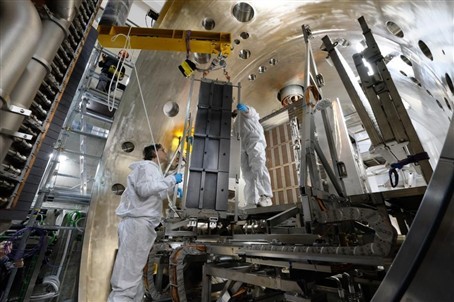SPIDER experiment delivers its first hydrogen beam

Members of Consorzio RFX installing diagnostics equipment, the STRIKE calorimeter, in SPIDER so as to monitor the operation of the beam source, March 2019, Padua, ITER Neutral Beam Test Facility
It has been a year since the inauguration of SPIDER, the world’s most powerful negative ion source at the service of the fusion community to master key technologies in the field of powerful heating systems. The knowledge acquired will be used in ITER. This is why it is hosted in the ITER Neutral Beam Test Facility (Padua, Italy), an international centre of scientific excellence. F4E, Consorzio RFX, ITER India, ITER Organization, together with approximately 120 companies, have contributed to this experiment by means of components, infrastructure and know-how. The value of components paid by F4E is in the range of 34 million EUR, while for India the investment has been roughly 3 million EUR. Consorzio RFX financed the construction paying approximately 25 million EUR. In the adjacent hall, another experiment – MITICA – is also in progress counting on contributions from F4E, Consorzio RFX, ITER Japan, ITER Organization.
Last June in front of 400 people the SPIDER beam source was switched on to produce its first plasma. The milestone was celebrated by delegates of the ITER parties involved, senior policy-makers, companies and scientists from all over Europe. Since then, it has been a year of operation, further tests and a lot of fine-tuning of the equipment. Recently SPIDER produced its first hydrogen beam. The news was well received by the scientific community paving the way for more tests. The experiment is in full R&D mode at the service of Consorzio RFX and ITER Organization. How much has SPIDER advanced since the experiment was officially unveiled?

Tullio Bonicelli, F4E Head of Neutral Beam & Electron Cyclotron, Power Supplies and Sources, has been following the evolution of the NBTF from the start. He identifies three recent turning points in the lifecycle of the experiment: “first, the integrated commissioning was successfully completed and all systems were qualified as operational, second, we witnessed the plasma in the ion source chamber, and last but not least, the beam extraction of ions and their acceleration was well managed.” Operating the beam source and addressing technical issues along the way has been a process of learning by doing. Antonio Masiello, F4E Technical Responsible Officer, managed the contract for the beam source which has been procured by Europe. He explains how SPIDER has the potential to become the new favourite facility for those in the field. “Compared to other experiments in this area, it is the first time that a beam source is completely immersed in vacuum replicating the operating conditions of the ITER environment.
Consequently, efforts were made to get the source operating with beam extraction. Thanks to these challenges, scientists involved in the experiments have been looking for ways to improve the performance of the beam source,” he explains. The set of SPIDER diagnostics is now commissioned validating fully its operation. Scientists can see the footprint of the beam source with infrared cameras.
Francesco Paolucci, F4E Technical Responsible Officer for the agreement between F4E and Consorzio RFX, has been instrumental in making this collaboration work both in paper and in practice. “All the systems are now up and running as part of the same equipment. They are no longer parts of a sum. Soon we will have some data to share and compare with other experiments around the world,” he states.
SPIDER may count only one year in operation. Yet, it feels as if it has come a long way. Its potential and the commitment shown by the experts working for it are a clear indication of its promising future in the fusion community and its contribution to ITER.